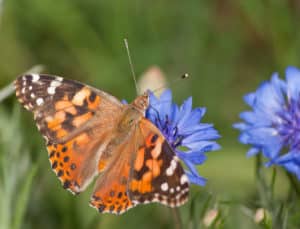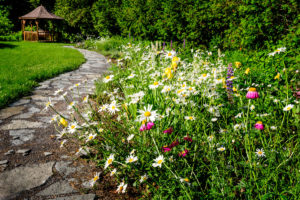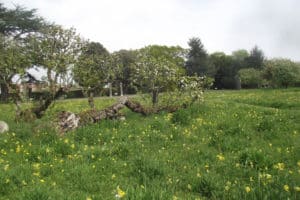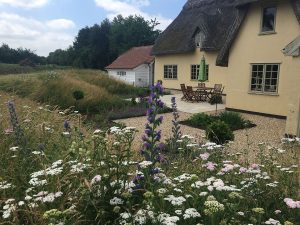22 Apr Using Wildflowers In Garden Design
Concerned about the state of our planet? We can all do our bit to boost biodiversity, starting with plants. Here are our tips on using wildflowers in garden design.
There are dozens of really good reasons to create a wildflower area in your garden. They’re a sure fire way of attracting more insects into your space and where insects appear, birds and amphibians are sure to follow. Add into the mix that wildflowers are generally very low maintenance and you have a win-win situation
- Many ecological and environmental benefits
- Wildflowers fit easily into a garden design
- Replace high maintenance lawns with low growing species rich meadow plantings
- Add wildflower species to your beds and borders
- Plant wildflowers in big drifts to attract more butterflies
- Create a relaxed, almost bohemian ambience
- Choose the subtle colours of perennial wildflowers
- Or go for bold, bright annual sowings
- Great for slopes and hard to access areas
- Superb for edging paths
- Mow paths and features into wild meadow areas and get up close to nature
How To Use Wildflowers In Garden Design
When you are considering your garden layout plan, aim to make at least one place for nature. Even if plants are not your top priority, they really do make a garden look ‘finished’. And you certainly don’t need to be a gardener to care for wild flowers. They only really need watering to get them established, definitely don’t need feeding, are very good at disguising weeds and rarely suffer from pests or diseases.
> Your wildflower area can be as subtle as a 30cm strip either side of a winding path.
> Or it can be as bold as a wonderful floral carpet.
> Perhaps you would enjoy sitting on a deck overlooking a wildlife pond and surrounded by the buzzing of bees in a wildflower area?
> Maybe you could ditch your lawnmower and just strim paths through the tall, flower studded grasses?
> Instead of formal terraces with expensive retaining walls, could you contour your garden to have wildflower encrusted slopes?
> Every garden has a corner or a tiny bit of land that poses a garden design challenge – why not turn it into a secluded wildlife area?
> Is there an area that always seems to lay wet? Could you turn it into a rain garden with some of our native wildflowers that like wetlands?
Bear in mind though, that wildflower meadow plantings are seasonal. They look fabulous in spring and summer, but once the flowers have faded in autumn, they can start to look a bit untidy. You perhaps need to bear that in mind while you are deciding where to position them.
Choose your species mix carefully- especially if your wildflower area is planned for a front garden. There’s a fine line between ‘wild and wonderful’ and ‘unkempt’ and in my experience the line varies between neighbours. Using wildflowers in garden design is all about making sure that they look as though they are meant to be there. And not as though you’ve forgotten to weed the garden!
Different Types Of Wildflower Plantings
Perennial Meadow Planting
I personally love perennial meadow planting. It’s beyond easy to look after and never fails to surprise you year after year. Perennial plants grow back every year and with a meadow type planting you should never have to re-plant it. Although I’m sure that once you get the wildflower bug you’ll find yourself trying to introduce new species into the mix.
Expect perennial meadow plantings to be a mixture of grasses and flowering plants and to grow around 60 cm high – that’s just over knee high to an average height person. You’ll have all year round ground cover which only needs cutting back once a year. Usually in early autumn.
Absolutely wonderful for a back garden or for carefully delineated areas in the front garden.
Establish from seed, from wildflower turf or by letting an area of the lawn grow long and “do its own thing”.
Low Growing Species Rich Lawns
In my opinion, low growing species rich lawns are gorgeous anywhere. They’re the perfect compromise between manicured lawns and full on wildflower meadows. Neat, colourful, sometimes scented, and very useable. They’re much lower maintenance than a grass-only lawn but just as hard wearing and much kinder to the environment than artificial grass.
Species rich lawns need mowing every couple of weeks or so with the mower blades on a high setting. Establish from seed, or from wildflower turf and then sit back and listen to the insects singing a ‘thankyou’ song. These are perennial – once established it will last a lifetime.
Wildflower area in the orchard at Helmingham Hall Gardens
Annual Wildflowers
For a really bright pop of colour and lots of wildlife interest, you can’t beat a drift of annual wildflowers. Poppies, cornflowers, corn marigolds – and if you are happy to include non-native species, cosmos, Californian poppy, marigolds and more.
Sow the seeds into prepared ground in autumn or in early spring and the plants will do the rest. Remember though, that these are ANNUAL plants. They grow, flower, set seed and die within a 12 month period and they grow best in recently disturbed soil. If you want to enjoy them year after year, you will need to dig over and re-seed the area every 12 months.
Check out higgledy garden for some great ideas for annual flowers that you can also cut and bring into the house. https://higgledygarden.com
Case study – How Tapestry Design Studios Used Wildflowers In Garden Design
Check out this case study for a garden in Writtle where wildflowers were used around a patio to help a garden feel part of the surrounding countryside.
Useful links
Growing wildflowers in your lawn
Need help deciding which plants to use in your garden design? Talk to us about planting plans.









No Comments